As students head to school—some for the first time—with their backpacks filled with new school supplies, it is time to round up some new school-themed stories for teachers, librarians, and parents to share with pre-K to sixth-grade students as they start the new school year.
Ages 4–8
Clothesline Clues to the First Day of School. Kathryn Heling & Deborah Hembrook. Ill. Andy Robert Davies. 2019. Charlesbridge.
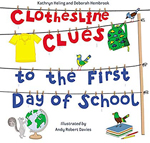 “High on the clothesline / hang clue after clue. / It’s the first day of school! / Who wants to meet you?” This picture book features rhyming riddles about the people children may encounter on their first day of school such as different teachers, the custodian, the crossing guard, the cafeteria worker, and fellow students. Double-page spreads featuring a clothesline hung with colorful clothing and items associated with each individual and a riddle offer children visual and textual clues to answer the recurring question “Who wants to meet you?” With a turn of the page, they see if their answer was correct.
“High on the clothesline / hang clue after clue. / It’s the first day of school! / Who wants to meet you?” This picture book features rhyming riddles about the people children may encounter on their first day of school such as different teachers, the custodian, the crossing guard, the cafeteria worker, and fellow students. Double-page spreads featuring a clothesline hung with colorful clothing and items associated with each individual and a riddle offer children visual and textual clues to answer the recurring question “Who wants to meet you?” With a turn of the page, they see if their answer was correct.
—JS
Did You Burp?: How to Ask Questions (or Not!) April Pulley Sayre. Ill. Leeza Hernandez. 2019. Charlesbridge.
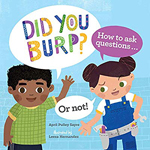 “Questions are the beginning of learning about the world. So be brave. Be bold. Ask questions!” This ask-out-loud story is perfect to teach young, curious children how to formulate questions. The book is divided into sections with headings like “Why ask questions?” or “How to ask a question” that teach effective question-asking strategies. April Pulley Sayre explores question words—who, what, when, where, how, and why—and helps readers know the right time to ask (or not ask) their questions. She even addresses what a question is not (for example, a story or comment). Leeza Hernandez’s digitally created illustrations feature children asking and responding to questions in accompanying speech bubbles.
“Questions are the beginning of learning about the world. So be brave. Be bold. Ask questions!” This ask-out-loud story is perfect to teach young, curious children how to formulate questions. The book is divided into sections with headings like “Why ask questions?” or “How to ask a question” that teach effective question-asking strategies. April Pulley Sayre explores question words—who, what, when, where, how, and why—and helps readers know the right time to ask (or not ask) their questions. She even addresses what a question is not (for example, a story or comment). Leeza Hernandez’s digitally created illustrations feature children asking and responding to questions in accompanying speech bubbles.
—SD
The King of Kindergarten. Derrick Barnes. Ill. Vanessa Brantley-Newton. 2019. Nancy Paulsen/Penguin.
 It’s the first day of kindergarten and enthusiasm is high for a little boy who is headed off to school for the first time. The second-person narrative invites the reader to feel like the little boy in the story—a young “prince” (as his mother calls him) ready to make his mark on the world, confident in his ability to be “the King of Kindergarten.” Filled with royal-themed phrases, this book takes the reader on a joyful journey into the “Kindergarten Kingdom” while details in brightly colored mixed-media illustrations keep the setting in a modern classroom and school.
It’s the first day of kindergarten and enthusiasm is high for a little boy who is headed off to school for the first time. The second-person narrative invites the reader to feel like the little boy in the story—a young “prince” (as his mother calls him) ready to make his mark on the world, confident in his ability to be “the King of Kindergarten.” Filled with royal-themed phrases, this book takes the reader on a joyful journey into the “Kindergarten Kingdom” while details in brightly colored mixed-media illustrations keep the setting in a modern classroom and school.
—JS
Linus The Little Yellow Pencil. Scott Magoon. 2019. Disney-Hyperion.
 Linus the Pencil is determined to win the grand prize at the family art show, but his eraser, Ernie, is complicating matters. Ernie didn’t like a single mark Linus made. “Rubba-dubba-rubb went Ernie, and Linus’s lines were gone.” Scott Magoon’s artistic puns bring an inanimate protagonist to life as jealous Linus sees other supplies creating their artwork. While watching Brush paint, he bristles with envy and thinks, “Must be nice to brush those cares aside.” The humor continues as Linus and Ernie struggle to create their own masterpiece. Frustrated, Linus is “drawn to the very edge” where, feeling “dull,” he enters a cave he has spied. Linus leaves the cave (a pencil sharpener) feeling much “sharper” with an artistic idea that just might work!
Linus the Pencil is determined to win the grand prize at the family art show, but his eraser, Ernie, is complicating matters. Ernie didn’t like a single mark Linus made. “Rubba-dubba-rubb went Ernie, and Linus’s lines were gone.” Scott Magoon’s artistic puns bring an inanimate protagonist to life as jealous Linus sees other supplies creating their artwork. While watching Brush paint, he bristles with envy and thinks, “Must be nice to brush those cares aside.” The humor continues as Linus and Ernie struggle to create their own masterpiece. Frustrated, Linus is “drawn to the very edge” where, feeling “dull,” he enters a cave he has spied. Linus leaves the cave (a pencil sharpener) feeling much “sharper” with an artistic idea that just might work!
—SD
Lola Goes to School (Lola Reads). Anna McQuinn. Ill. Rosalind Beardshaw. 2019. Charlesbridge.
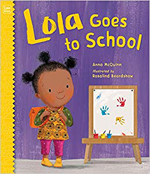 In Anna McQuinn’s latest book, charming, book-loving Lola is starting school. First-time school-goers will relate to Lola’s feelings of excitement and anticipation as she packs her school bag, picks out her first-day outfit, and walks to school with her mom. During the day, Lola reads books, participates in group activities, and goes outside to play with her new friends. At the end of the day, mom arrives to walk her home and after a having a snack, a happy but tired Lola falls asleep. A simple text and brightly colored acrylic artwork perfectly depict the school setting and Lola’s diverse group of classmates.
In Anna McQuinn’s latest book, charming, book-loving Lola is starting school. First-time school-goers will relate to Lola’s feelings of excitement and anticipation as she packs her school bag, picks out her first-day outfit, and walks to school with her mom. During the day, Lola reads books, participates in group activities, and goes outside to play with her new friends. At the end of the day, mom arrives to walk her home and after a having a snack, a happy but tired Lola falls asleep. A simple text and brightly colored acrylic artwork perfectly depict the school setting and Lola’s diverse group of classmates.
—JS
Nugget & Fang Go to School (Nugget & Fang #2). Tammi Sauer. Ill. Michael Slack. 2019. Clarion/Houghton Mifflin.
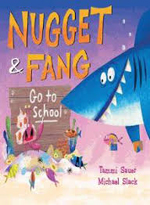 In this story about an unlikely ocean friendship between Nugget, a mini minnow, and Fang, a vegetarian shark, Nugget and the other minnows, who are thankful to have Fang as a friend, want him to attend Mini Minnows Elementary with them. Fang has his reservations. “What if I yawn and accidentally swallow someone? What if a whale accidentally swallows me?” Nugget tells him, “You’ll be fine.” As Fang struggles in every subject at school, his small friend is there to offer reassurances and shows him how special it is to have a best friend. Young readers will delight in the ironic twists of Tami Sauer’s first-day-of-school story and the warm humor of Michael Slack’s colorful, digitally created cartoon illustration.
In this story about an unlikely ocean friendship between Nugget, a mini minnow, and Fang, a vegetarian shark, Nugget and the other minnows, who are thankful to have Fang as a friend, want him to attend Mini Minnows Elementary with them. Fang has his reservations. “What if I yawn and accidentally swallow someone? What if a whale accidentally swallows me?” Nugget tells him, “You’ll be fine.” As Fang struggles in every subject at school, his small friend is there to offer reassurances and shows him how special it is to have a best friend. Young readers will delight in the ironic twists of Tami Sauer’s first-day-of-school story and the warm humor of Michael Slack’s colorful, digitally created cartoon illustration.
—SD
Pencil: A Story With a Point. Ann Ingalls. Ill. Dean Griffiths. 2019. Pajama Press.
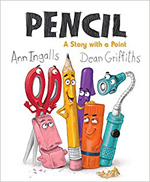 Young Jackson loves Pencil! They draw, sketch, and doodle all day until Tablet moves in and tries to take Pencil’s place as Jackson’s new go-to tool. When Pencil is banished to the dreaded Junk Drawer, he meets up with other discarded tools like Scissors, Eraser, Ruler, and Marker. What will it take for Pencil to make his mark and win his way back into Jackson’s heart? Dean Griffiths’ digitally rendered cartoon illustrations featuring animated school supplies complement Ann Ingalls’ clever, pun-filled story which has a point to make: New tools are not always better than old ones.
Young Jackson loves Pencil! They draw, sketch, and doodle all day until Tablet moves in and tries to take Pencil’s place as Jackson’s new go-to tool. When Pencil is banished to the dreaded Junk Drawer, he meets up with other discarded tools like Scissors, Eraser, Ruler, and Marker. What will it take for Pencil to make his mark and win his way back into Jackson’s heart? Dean Griffiths’ digitally rendered cartoon illustrations featuring animated school supplies complement Ann Ingalls’ clever, pun-filled story which has a point to make: New tools are not always better than old ones.
—JS
The Pigeon HAS to Go to School! Mo Willems. 2019. Disney-Hyperion.
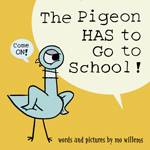 “WAIT! Don’t read that title! / Too late. Rats . . . / Why do I have to go to school?” The hilarious pigeon returns with his notorious excuses and rebuttals to convince young readers that he doesn’t need to go to school. After all, he already knows EVERYTHING! “Well, I know almost everything,” he admits. Readers can expect the usual format of Pigeon front and center on bright backgrounds, surrounded by wildly shaped speech bubbles. Mo Willems also adds lines, loose feathers, and other symbols to his illustrations to capture Pigeon’s frantic emotions, adding to the fun of the reading experience. The front endpaper features empty desks and chairs, while the back endpaper shows all kinds of birds (including Pigeon) sitting at desks, ready to learn.
“WAIT! Don’t read that title! / Too late. Rats . . . / Why do I have to go to school?” The hilarious pigeon returns with his notorious excuses and rebuttals to convince young readers that he doesn’t need to go to school. After all, he already knows EVERYTHING! “Well, I know almost everything,” he admits. Readers can expect the usual format of Pigeon front and center on bright backgrounds, surrounded by wildly shaped speech bubbles. Mo Willems also adds lines, loose feathers, and other symbols to his illustrations to capture Pigeon’s frantic emotions, adding to the fun of the reading experience. The front endpaper features empty desks and chairs, while the back endpaper shows all kinds of birds (including Pigeon) sitting at desks, ready to learn.
—SD
When Pencil Met Eraser.Karen Kilpatrick & Luis O. Ramos, Jr. Ill. Germán Blanco. 2019. Imprint/Macmillan.
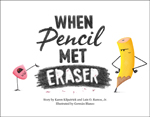 Did you ever wonder how Pencil and Eraser came to be linked with each other? This humorous picture book takes a stab at explaining how the two friends started out as separate entities and eventually paired up to become the handy writing tool we all use. Readers of this imaginative story (with illustrations drawn in pencil, of course) watch the drama of this fortuitous meeting unfold as Pencil’s drawings are changed and improved upon with the help of Eraser.
Did you ever wonder how Pencil and Eraser came to be linked with each other? This humorous picture book takes a stab at explaining how the two friends started out as separate entities and eventually paired up to become the handy writing tool we all use. Readers of this imaginative story (with illustrations drawn in pencil, of course) watch the drama of this fortuitous meeting unfold as Pencil’s drawings are changed and improved upon with the help of Eraser.
—JS
Ages 9–11
Bigger, Badder, Nerdier (Geeked Out #2). Obert Skye. 2019. Christy Ottaviano/Henry Holt/Macmillan.
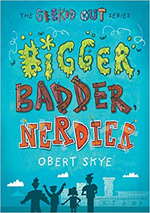 In this sequel to Geeked Out (2018), Tip and his nerdy friends Owen, Mindy, and Xen return with their secret vigilante group, the League of Average and Mediocre Entities (aka LAME) to save their school, once again, from the evil secretary, Mrs. “Darth” Susan. With their world facing semi-apocalyptic conditions after the release of a terrible movie, the foursome must use their “mediocre” powers—super hearing and glowing eyes (Owen), deadly claps (Mindy), destructive burps (Xen), and electronic mind control (Tip)— to unveil Darth Susan’s mysterious plan and out-geek an imposter LAME group, before their school is doomed! Obert Skye uses spoof tactics in his text and graphics, transitioning smoothly between the two, to poke fun at the comical similarities of occurrences in the book and the real world.
In this sequel to Geeked Out (2018), Tip and his nerdy friends Owen, Mindy, and Xen return with their secret vigilante group, the League of Average and Mediocre Entities (aka LAME) to save their school, once again, from the evil secretary, Mrs. “Darth” Susan. With their world facing semi-apocalyptic conditions after the release of a terrible movie, the foursome must use their “mediocre” powers—super hearing and glowing eyes (Owen), deadly claps (Mindy), destructive burps (Xen), and electronic mind control (Tip)— to unveil Darth Susan’s mysterious plan and out-geek an imposter LAME group, before their school is doomed! Obert Skye uses spoof tactics in his text and graphics, transitioning smoothly between the two, to poke fun at the comical similarities of occurrences in the book and the real world.
—SD
The Friendship War. Andrew Clements. 2019. Random House.
 Sixth grader Grace returns home from a visit with her grandfather right before the start of the new school year with boxes of buttons from an old mill he is planning to renovate. When her teacher announces that they will be studying the Industrial Revolution, Grace brings a few buttons into school to show her classmates. Her friends are intrigued by the buttons and before you know it, Grace has inadvertently started a new fad of button collecting, causing the sixth graders to go bonkers for buttons! Swept up in a button-trading frenzy, Grace finds herself in a feud with her best friend, Ellie, while also making a new friend named Hank, who shares her love for data collection and history. Upper elementary readers will enjoy finding out how Grace discovers a way to stop the fad and save her friendship in Andrew Clements’ newest school story.
Sixth grader Grace returns home from a visit with her grandfather right before the start of the new school year with boxes of buttons from an old mill he is planning to renovate. When her teacher announces that they will be studying the Industrial Revolution, Grace brings a few buttons into school to show her classmates. Her friends are intrigued by the buttons and before you know it, Grace has inadvertently started a new fad of button collecting, causing the sixth graders to go bonkers for buttons! Swept up in a button-trading frenzy, Grace finds herself in a feud with her best friend, Ellie, while also making a new friend named Hank, who shares her love for data collection and history. Upper elementary readers will enjoy finding out how Grace discovers a way to stop the fad and save her friendship in Andrew Clements’ newest school story.
—JS
Parker Bell and the Science of Friendship. Cynthia Platt. Ill. Rea Zhai. 2019. Clarion/Houghton Mifflin.
 Parker Bell loves all things science and hopes to be a famous scientist someday, just like her idols Jane Goodall and Mae Jemison. She even has a Mad Science Lab in her house to create fantastic contraptions and conduct experiments. So, when her teacher announces that they are going to participate in the Science Triathlon, Parker’s enthusiasm level is through the roof. She’s excited to pair up with her best friend, Cassie, but isn’t sure what to think when Cassie invites Theo to join them. Will Theo prove to be a valuable partner in their quest for the gold medal? Readers find out in this story about friendship, teamwork, and the scientific method.
Parker Bell loves all things science and hopes to be a famous scientist someday, just like her idols Jane Goodall and Mae Jemison. She even has a Mad Science Lab in her house to create fantastic contraptions and conduct experiments. So, when her teacher announces that they are going to participate in the Science Triathlon, Parker’s enthusiasm level is through the roof. She’s excited to pair up with her best friend, Cassie, but isn’t sure what to think when Cassie invites Theo to join them. Will Theo prove to be a valuable partner in their quest for the gold medal? Readers find out in this story about friendship, teamwork, and the scientific method.
—JS
President of Poplar Lane (Poplar Kids #2). Margaret Mincks. 2019. Viking/Penguin.
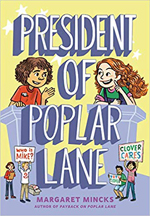 Poplar Lane neighbors Clover O’Reilly and Michael Strange find themselves running against each other for class president, but are they each running for the right reasons? Clover, whose family of seven is about to include yet another sister, likes the idea of having an office to decorate since she must continue sharing a bedroom. Alternating chapters reveal Clover’s and Mike’s points of view. Mike “the Unusual” prefers performing magic over playing sports and hopes a presidential win will please his disapproving father and boost his Magic Camp application. Occasional inserts provide additional context in the storyline such as daily online posts from blogger Mel Chang as she follows the week-long election campaign.
Poplar Lane neighbors Clover O’Reilly and Michael Strange find themselves running against each other for class president, but are they each running for the right reasons? Clover, whose family of seven is about to include yet another sister, likes the idea of having an office to decorate since she must continue sharing a bedroom. Alternating chapters reveal Clover’s and Mike’s points of view. Mike “the Unusual” prefers performing magic over playing sports and hopes a presidential win will please his disapproving father and boost his Magic Camp application. Occasional inserts provide additional context in the storyline such as daily online posts from blogger Mel Chang as she follows the week-long election campaign.
—SD
Skye Deiter is an elementary classroom teacher in Harrisburg, Pennsylvania, and a recent graduate from Pennsylvania State Harrisburg’s Masters in Literacy Education Program.Jennifer W. Shettel is a professor at Millersville University of Pennsylvania, where she teaches undergraduate and graduate courses in literacy for preservice and practicing teachers. Prior to joining the faculty at Millersville, she spent 16 years as an elementary classroom teacher and reading specialist in the public schools.
These reviews are submitted by members of the International Literacy Association's Children's Literature and Reading Special Interest Group (CL/R SIG) and are published weekly on Literacy Daily.